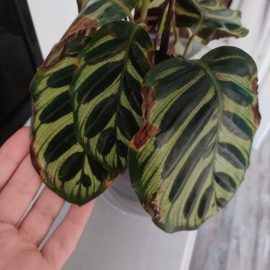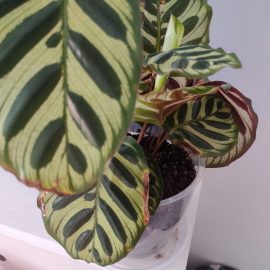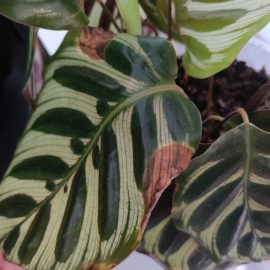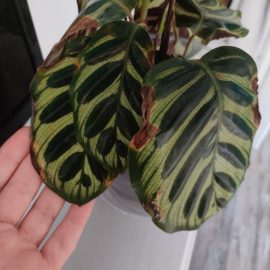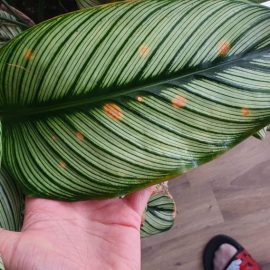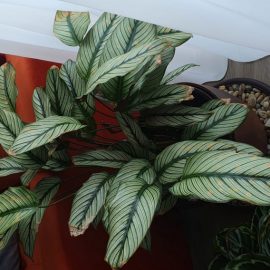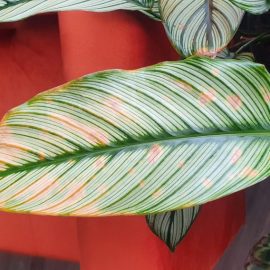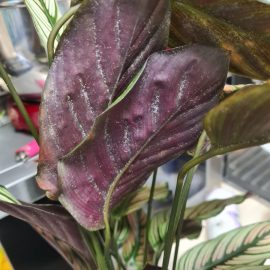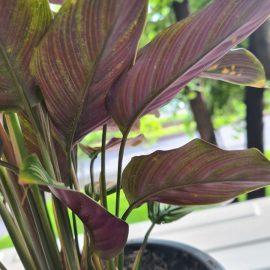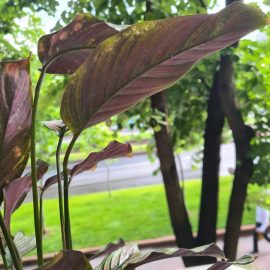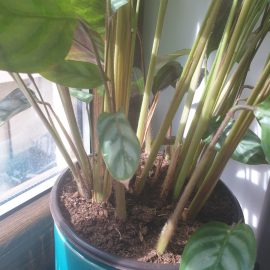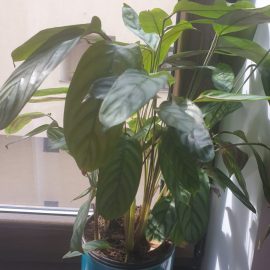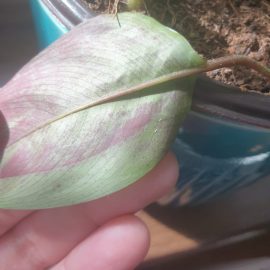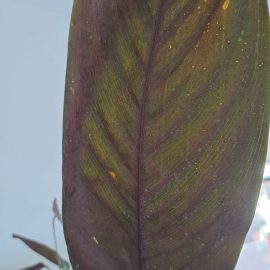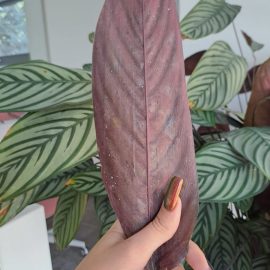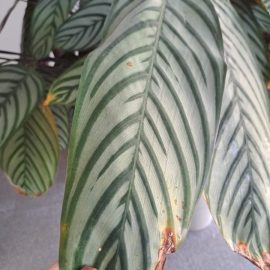Calathea, plant care and growing guide
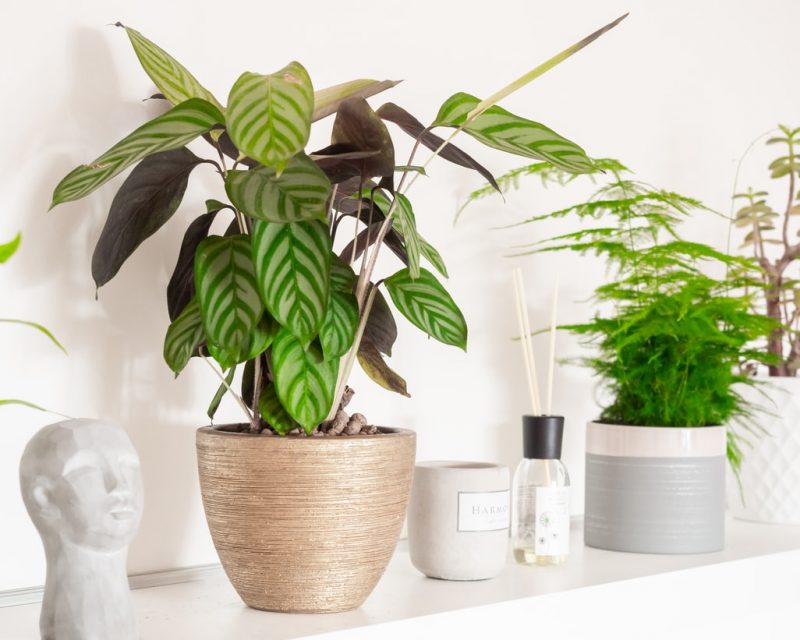
Calathea is a tropical plant, native to the forests of Central America, where the air is warm and the humidity is relatively high. Of the 150 species of Calathea, only one produces flowers, the others being remarkable for their leaves.





Species and cultivars
Calathea crocata. It is a species known for its brightly colored flowers (orange, yellow, or red) and their distinct, flame-like appearance. They grow at the top of long stems. The upper side of the leaves has a metallic green appearance, with small, purple dents, while the underside has a purple, slightly brown coloring.
Calathea makoyana. This species is widely appreciated for its leaves that resemble a rooster’s plumage. They are pale green, with dark-green inserts, which are arranged starting from the middle and extending towards the outer edges of the leaf – this gives the leaves a feather-like effect. The new leaves that grow are twisted and red, slightly pink, which intensifies the visual effect of a rooster’s tail.
Calathea ornata. It is a special species, with glossy leaves, colored in dark green, with pale pink ribs when the plant is young, and which become white when the leaves age.
Calathea insignis. It is a unique plant, distinguished by its elongated, lanceolate leaves with wavy edges, which are colored in light green and have dark green spots. On the underside, they have a purple-reddish color.
Calathea zebrina. Like other species of the genus Calathea, it is characterized by its light green, striped leaves, with dark inserts. However, unlike the rest of the species, Calathea zebrina has large, matte leaves, which are arranged horizontally. On the underside, the leaves are dark purple.
Environmental conditions
Light. It is very important for the plants to be placed away from direct sunlight and, as far as possible, for their position to not be changed.
Temperature. The optimum temperature range for the plant to grow is 18-25° C.
Humidity. Due to its tropical origins, the plant must be provided with optimal humidity inside the room in which it is placed. Thus, dry air is not exactly favorable for its growth and development. However, placing the plant in a cool room does not represent a solution, because Calathea species do not tolerate temperatures below 15° C. To give it extra humidity, it is advisable to place it next to other plants.
Substrate. It prefers a slightly acidic substrate. The substrate must allow good water drainage.
Recommended products
-
You can find products on a different store
Change Store -
You can find products on a different store
Change Store -
You can find products on a different store
Change Store -
You can find products on a different store
Change Store -
You can find products on a different store
Change Store -
You can find products on a different store
Change Store -
You can find products on a different store
Change Store -
You can find products on a different store
Change Store -
You can find products on a different store
Change Store -
You can find products on a different store
Change Store -
You can find products on a different store
Change Store -
You can find products on a different store
Change Store -
You can find products on a different store
Change Store -
You can find products on a different store
Change Store -
You can find products on a different store
Change Store -
You can find products on a different store
Change Store -
You can find products on a different store
Change Store -
You can find products on a different store
Change Store -
You can find products on a different store
Change Store -
You can find products on a different store
Change Store -
You can find products on a different store
Change Store -
You can find products on a different store
Change Store -
You can find products on a different store
Change Store -
You can find products on a different store
Change Store
Care
Watering. Regarding the water volume and the watering’s frequency, it is recommended to add small volumes of water, whenever the soil is dry on the surface, on average every 2-3 days (these values are indicative, as they depend on several factors: room temperature, substrate, plant height, etc.). During the summer, in particular, the leaves should be sprayed with rainwater or with non-calcareous water, to provide the plant with a favorable environment. During the winter, if the indoor temperatures are lower, the frequency of watering should be reduced.
Fertilization. For your plant to benefit from all the nutrients it needs for rich growth, beautiful flowers, and healthy leaves, it is advisable to apply fertilizer for indoor plants. However, its use should be interrupted in winter.
Recommended products
-
You can find products on a different store
Change Store -
You can find products on a different store
Change Store -
You can find products on a different store
Change Store -
You can find products on a different store
Change Store -
You can find products on a different store
Change Store -
You can find products on a different store
Change Store -
You can find products on a different store
Change Store -
You can find products on a different store
Change Store -
You can find products on a different store
Change Store -
You can find products on a different store
Change Store -
You can find products on a different store
Change Store -
You can find products on a different store
Change Store -
You can find products on a different store
Change Store -
You can find products on a different store
Change Store -
You can find products on a different store
Change Store -
You can find products on a different store
Change Store -
You can find products on a different store
Change Store -
You can find products on a different store
Change Store -
You can find products on a different store
Change Store -
You can find products on a different store
Change Store -
You can find products on a different store
Change Store -
You can find products on a different store
Change Store -
You can find products on a different store
Change Store -
You can find products on a different store
Change Store
Repotting. The best time to repot the plant is in March-April. Moving it to a new pot should be done once every one or two years, using a new substrate.
Propagation. The plant can be propagated through division when transplanted. The new cuttings should be planted in slightly wider pots, which must correspond to the size of the roots. The pots with the new plants should be covered with polyethylene foil and kept warm until they recover and show new growths.
Recommended products
-
You can find products on a different store
Change Store -
You can find products on a different store
Change Store -
You can find products on a different store
Change Store -
You can find products on a different store
Change Store -
You can find products on a different store
Change Store -
You can find products on a different store
Change Store -
You can find products on a different store
Change Store -
You can find products on a different store
Change Store -
You can find products on a different store
Change Store -
You can find products on a different store
Change Store -
You can find products on a different store
Change Store -
You can find products on a different store
Change Store -
You can find products on a different store
Change Store -
You can find products on a different store
Change Store -
You can find products on a different store
Change Store -
You can find products on a different store
Change Store -
You can find products on a different store
Change Store -
You can find products on a different store
Change Store -
You can find products on a different store
Change Store -
You can find products on a different store
Change Store -
You can find products on a different store
Change Store -
You can find products on a different store
Change Store -
You can find products on a different store
Change Store -
You can find products on a different store
Change Store
Recommended products
-
You can find products on a different store
Change Store -
You can find products on a different store
Change Store -
You can find products on a different store
Change Store -
You can find products on a different store
Change Store -
You can find products on a different store
Change Store -
You can find products on a different store
Change Store -
You can find products on a different store
Change Store -
You can find products on a different store
Change Store -
You can find products on a different store
Change Store -
You can find products on a different store
Change Store -
You can find products on a different store
Change Store -
You can find products on a different store
Change Store -
You can find products on a different store
Change Store -
You can find products on a different store
Change Store -
You can find products on a different store
Change Store -
You can find products on a different store
Change Store -
You can find products on a different store
Change Store -
You can find products on a different store
Change Store -
You can find products on a different store
Change Store -
You can find products on a different store
Change Store -
You can find products on a different store
Change Store -
You can find products on a different store
Change Store -
You can find products on a different store
Change Store -
You can find products on a different store
Change Store
Diseases and pests.
Calathea is sensitive to mite infestation.
Recommended products
-
You can find products on a different store
Change Store -
You can find products on a different store
Change Store -
You can find products on a different store
Change Store -
You can find products on a different store
Change Store -
You can find products on a different store
Change Store -
You can find products on a different store
Change Store -
You can find products on a different store
Change Store -
You can find products on a different store
Change Store -
You can find products on a different store
Change Store -
You can find products on a different store
Change Store -
You can find products on a different store
Change Store -
You can find products on a different store
Change Store -
You can find products on a different store
Change Store -
You can find products on a different store
Change Store -
You can find products on a different store
Change Store -
You can find products on a different store
Change Store -
You can find products on a different store
Change Store -
You can find products on a different store
Change Store -
You can find products on a different store
Change Store -
You can find products on a different store
Change Store -
You can find products on a different store
Change Store -
You can find products on a different store
Change Store -
You can find products on a different store
Change Store -
You can find products on a different store
Change Store
How to choose a Calathea crocata plant. When buying such a plant, make sure that it is in bloom. Choose a plant with green and glossy leaves, with many flower buds.
Useful advice:
- in order to bloom, Calathea needs a period in which the days are short and the nights are long.
- Calathea is very sensitive to sudden temperature variations, therefore, it is preferable to maintain a constant room temperature.
- to stimulate the rejuvenation of the plant, remove the dried leaves regularly.
- it grows excellently in greenhouses, along with Ficus plants.
- wipe the leaves with a damp cloth whenever dust appears on them.
- the harmonious growth and development of the plant can be achieved in a warm environment, with relatively high humidity, sufficient water, and away from direct sunlight.
Possible problems and the causes of their occurrence:
- brown edges of the leaves and a slow growth of the plant – the humidity is too low.
- curled leaves and spots on leaves (the basal leaves are yellowing) – insufficient water.
- The softening and rotting of the stems and the dropping of the leaves – the temperature is too low.














































































































































































































































































































































































































































